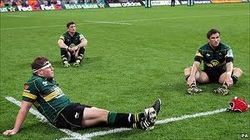
Fatigue, like perspiration and aging, is an inevitable feature in the career of any athlete. Fatigue is both a physical and a mental state, representing that point in a difficult training session or competition when the body demonstrates a reduced ability to work efficiently, with a feeling of weariness that cannot be mentally overcome. Fatigue can develop over a short period of time in the course of an event or in practice. It may also slowly develop in the athlete as a cumulative effect after weeks or months of intense physical effort.As fatigue can occur in both training and in competitive situations, it is a condition largely determined by the approach taken by an athlete to workouts. Both the duration of training sessions and their intensity are factors underlying the presence of fatigue. The relationship between workouts and a competitive schedule is also an important consideration. The existence of fatigue, and the ability of the body to overcome its effects, is also closely linked to diet and nutrition, the quality of sleep enjoyed by the athlete, scheduled recovery periods, and external factors such as employment pressures, educational studies, and injury. Fatigue is generally episodic. By addressing the identified underlying causes of fatigue, an athlete can reduce or eliminate its impact upon athletic performance very quickly. When the symptoms of fatigue continue in the face of efforts to eliminate them, the athlete must consider the possible existence of chronic fatigue syndrome, a physical condition that requires a comprehensive medical review. Exercise quality can be assessed using two different yardsticks. The power with which an athlete can perform is closely related to the concept of the intensity of the exercise. The intensity will be tied to such physical factors as the maximum oxygen uptake of the athlete (known as the VO2 max), the power of the heart to propel blood through the body, and muscular strength. The second measure is the work capacity of the athlete—the amount of exercise that can be performed. Using the power / intensity and work / capacity definitions, fatigue presents in some important aspects of athletic performance. Muscle fatigue is the most common kind of reduction of physical capacity. Muscle fatigue is a decrease in the available power coming from the muscle over time, and it arises in three different scenarios. In short distance activities such as sprinting, when the muscle is directed to make a maximum number of muscle contractions in a short period of time, fatigue sets into the muscle when the fast-twitch fibers cannot maintain muscle tension. Through training techniques such as interval training, the muscle fibers are conditioned to respond for longer periods to keep fatigue away from the function for longer periods. In longer activities such as distance running, the muscles are directed to contract more slowly, through the present slow-twitch fibers. In these types of activities, the fatigue will arise through a combined effect of muscle repetition and depleted energy stores. Localized muscle fatigue occurs in sports such as kayaking or distance cycling, when a large muscle group is working on an anaerobic basis and the balance of the body is being powered aerobically; the anaerobically powered muscles will experience fatigue not experienced in the rest of the body. Fatigue has a pronounced impact upon the central nervous system and its functions. A fatigued system will tend to have a heightened sensitivity to cold, as well as a reduced ability to maintain a body temperature to prevent the onset of hypothermia (a potentially fatal cold weather condition in which many systems of the body, including optimal brain function, begin to fail when the body temperature is reduced to 95°F [35°C] or below). Tired sailors who fall into cold water will tend to have their body temperature fall at twice the rate as those who enter the same waters but are otherwise relatively rested. In such circumstances, the thought processes of the tired sailor quickly become impaired, and the ability of this person to make decisions regarding rescue options are much reduced. The effects of fatigue are also demonstrated upon the cognitive and the learning capabilities of athletes in both training and in competition. Coaches seeking to teach a technique to an athlete will have greater instructional success earlier in an intense workout, as the athlete will be able to focus on the teaching message without the interference of the fatigue signals sent by the body. In team sports, instruction to the team is often best reserved for a distinct strategy session as opposed to the practice field for this reason.
 RSS Feed
RSS Feed
